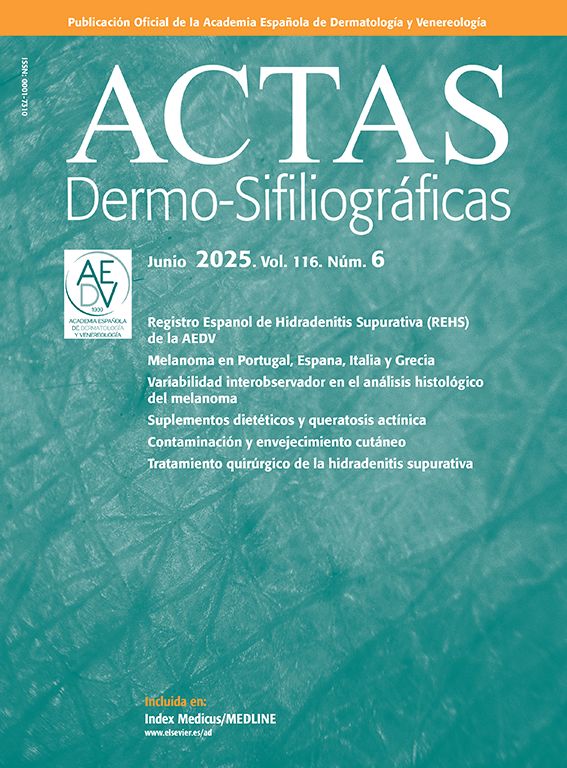Antecedentes y Objetivos: Existe una ausencia de estudios centrados en el recuento de nevus melanocíticos adquiridos (NMA) interdigitales de los pies (NIDp). Nuestro objetivo fue estudiar la relación de la presencia de NIDp con el número total de NMA de los pies y del resto del cuerpo, las características fenotípicas raciales y otros factores de riesgo de melanoma.
Material y métodos: Se realizó un estudio observacional transversal que incluyó a 255 pacientes, ≥18 años, que acudieron nuestro servicio de Dermatología desde septiembre de 2020 a febrero de 2021. Se registraron todos los NMA ≥1 mm de los pies y ≥ 2mm del resto del cuerpo. Se estudió la asociación entre las variables mediante un modelo de regresión logística uni y multivariante.
Resultados: La presencia de NIDp se asoció de manera estadísticamente significativa e independiente con la presencia de NMA plantares y con recuentos de ≥50 NMA en el cuerpo. Sin embargo, no se observaron diferencias significativas respecto al sexo, la edad, los antecedentes personales de melanoma, la presencia de nevus en el dorso de los pies, antecedentes de quemaduras solares o rayos UVA, ni con características fenotípicas raciales.
Conclusiones: La presencia de NIDp se relaciona con un mayor recuento de nevus plantares y NMA totales del cuerpo, lo que puede significar que los espacios interdigitales son una expansión anatómica de la planta del pie y que otras causas, posiblemente genéticas, serían responsables del número de NMA en esta localización, al ser zonas nada fotoexpuestas.
Background and Objectives: There is an absence of studies focused on the count of interdigital acquired melanocytic nevi (AMN) of the feet (IPN). Our objective is to study the relationship between the presence of NIDp with the total number of NMA in the feet and the rest of the body, racial phenotypic characteristics, and other risk factors for melanoma.
Material and methods: A cross-sectional observational study was carried out that included 255 patients, ≥18 years old, who attended our Dermatology service from September 2020 to February 2021. All NMAs ≥1 mm from the feet and ≥ 2 mm from the rest of the body. The association between the variables was studied using a univariate and multivariate logistic regression model.
Results: The presence of NIDp was significantly and independently associated with the presence of plantar NMA and with body counts of ≥50 NMA. However, no significant differences were observed for sex, age, personal history of melanoma, the presence of nevus on the dorsum of the feet, history of sunburn or UVA rays, or racial phenotypic characteristics.
Conclusions: The presence of NIDp is related to a higher count of plantar nevi and total NMA in the body, which may mean that the interdigital spaces are an anatomical expansion of the sole and that other causes, possibly genetic, would be responsible for the number of NMA in this location, as they are not photo exposed areas.




